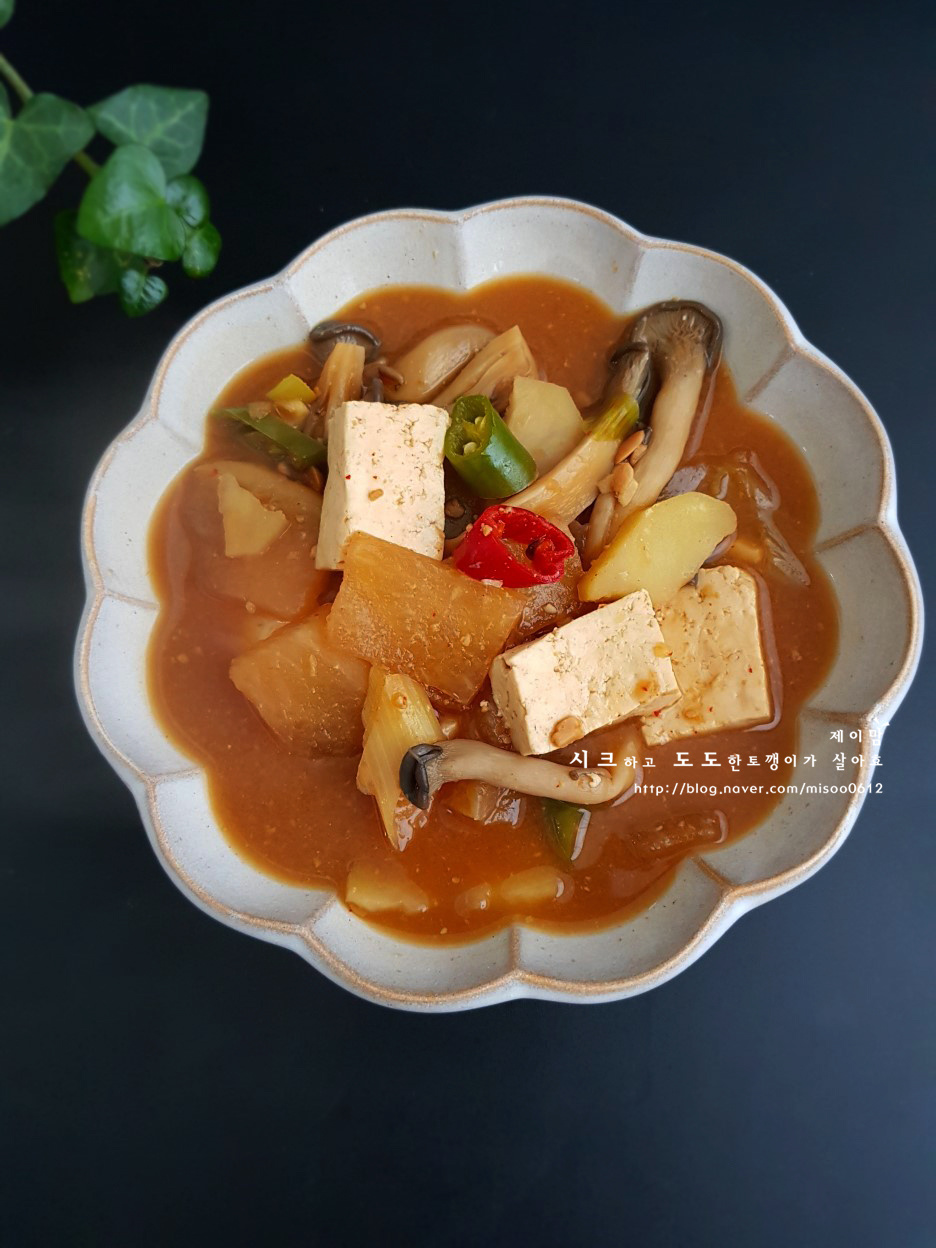Rich and Savory Doenjang Jjigae: A Comforting Korean Stew Recipe
How to Make Delicious Doenjang Jjigae (Korean Soybean Paste Stew)

This recipe brings you a comforting bowl of traditional Doenjang Jjigae, easily made with ingredients you likely have on hand. Using rice water as a base creates a deep, savory broth, and you can customize it with your favorite vegetables and tofu. Get ready to fall in love with this addictive stew that pairs perfectly with a hot bowl of rice!
Core Stew Ingredients- 4 Tbsp Doenjang (Korean soybean paste – homemade or store-bought)
- 8 cups Rice Water (approx. 1.6L)
- 150g Korean Radish (daikon) (about a handful)
- 0.5 Tbsp Minced Garlic
- 0.3 Tbsp Sugar (enhances savory notes)
- 0.5 Tbsp Gochugaru (Korean chili flakes – adjust to taste)
- 0.5 Tbsp Dried Anchovy Powder (or dried anchovies for broth)
Optional Ingredients for Extra Flavor- 1/2 block Firm Tofu
- 1 small Potato
- 1 handful King Oyster Mushrooms (or other mushrooms like shiitake)
- 1 Korean Green Chili (Cheongyang chili for heat)
- 1/4 bunch Scallions (Green Onions)
- 1/2 Red Chili (for color)
- 1/2 block Firm Tofu
- 1 small Potato
- 1 handful King Oyster Mushrooms (or other mushrooms like shiitake)
- 1 Korean Green Chili (Cheongyang chili for heat)
- 1/4 bunch Scallions (Green Onions)
- 1/2 Red Chili (for color)
Cooking Instructions
Step 1
First, prepare all the ingredients for the stew. Slice the Korean radish into thin, bite-sized pieces, about 0.5cm thick. Cut the tofu into 1.5cm cubes. Peel the potato and slice it thinly, about 0.5cm thick. Finely slice the Cheongyang and red chilies diagonally, removing the seeds if you prefer less heat. Slice the scallions diagonally as well. Separate the king oyster mushrooms into individual pieces.

Step 2
In a pot, add 8 cups of rice water and the sliced Korean radish. Bring to a rolling boil over high heat for about 10 minutes, allowing the radish to become slightly translucent and the flavors to infuse into the water. Rice water, the cloudy water left after rinsing rice, adds a wonderful depth and subtle sweetness to the stew.

Step 3
Once the radish has softened slightly, dissolve 4 tablespoons of Doenjang into the broth and bring it back to a boil. It’s crucial to adjust the amount of Doenjang based on its saltiness and your preference. I used a store-bought brand (Sempio), but if you’re using homemade Doenjang, be extra mindful of the salt content. Skim off any foam that rises to the surface for a cleaner broth.

Step 4
After adding the Doenjang and letting it boil for a moment, reduce the heat to low. Cover the pot and simmer for another 15 to 20 minutes. This slow simmering allows the natural sweetness of the radish to meld with the Doenjang, creating a richer, more complex flavor profile.

Step 5
Now it’s time to add the seasonings that will elevate the stew’s taste. In a small bowl, combine 0.5 Tbsp minced garlic, 0.5 Tbsp dried anchovy powder, 0.5 Tbsp gochugaru, and 0.3 Tbsp sugar. Stir them together and add to the pot. If you don’t have anchovy powder, you can add a few cleaned dried anchovies while the stew simmers and remove them later. The sugar helps to balance the slight bitterness of the Doenjang and enhances the overall umami.

Step 6
Add all the prepared ingredients: tofu cubes, king oyster mushrooms, sliced chilies, and scallions, along with the thinly sliced potatoes. Bring the stew back to a rolling boil over medium-high heat. Be careful not to overcook at this stage, as the vegetables can become mushy.

Step 7
Finally, let the stew simmer until the potatoes are tender and the tofu has absorbed the delicious flavors of the Doenjang broth. This should take about 5 more minutes. Taste the stew and adjust the seasoning if needed, adding more Doenjang or a pinch of salt if necessary.

Step 8
Your flavorful and comforting Doenjang Jjigae is ready! Serve it hot with a bowl of steamed rice for a truly satisfying Korean meal. It’s the perfect dish to warm you up on a chilly day.



